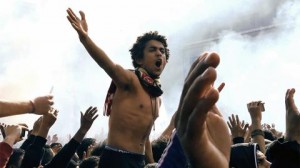On the 8th of February 2015, a clash erupted between police and football fans outside of the military-owned Air Defense Stadium in Cairo, Egypt. Estimates of how many were killed range from 19 to 40, but most sources estimate 22 deaths, with numerous more injured.
There are varying accounts as to what happened and the cause of the events. Al Jazeera reported that supporters of the Zamalek football club tried to force their way into the stadium, creating a stampede. Police then reportedly used tear gas on the crowding fans, and violent struggles began. CNN reports a similar story, noting that the fans stampeding the stadium were ones without tickets attempting to get into the game. BBC includes a slightly different side of the story- Zamalek fans accuse the police around the stadium of forcing them through a fenced-in, narrow passageway entrance, creating a stampede.
The Egyptian football league has been indefinitely suspended while the investigation of this event occurs.
Yet, this already complicated issue is actually much more complex under the surface. Historical context reveals a slew of underlying tensions adding to the conflict.
Let’s go back to the Port Said stadium riot, on the 1st of February 2012, in which 72 people were killed due to fighting between fans. Al Jazeera reports that the fans groups Al-Masry and Al-Ahly, each belonging to an Egyptian football club, clashed at Port Said stadium, resulting in bloodshed and deaths. Football in Egypt was then indefinitely suspended, starting up again a year after the event. Yet, ever since the tragic event, the amount of fans allowed to attend matches has been seriously curbed. In fact, fans weren’t even allowed to attend matches until December of 2014, just weeks before the recent violence in Cairo, where very limited tickets were sold and few people let in (BBC reports that only 5,000 tickets were sold for the recent match in Air Defense Stadium, which can actually hold up to 30,000 spectators).
But there’s more. Al Jazeera also reports that it was the Al-Masry fans that attacked the Al-Ahly fans- with explosives, knives, and broken glass. And it gets weirder. Two police officers were sentenced to 15 years in jail for ‘gross negligence’ in relation to the riots. BBC reports that police supposedly failed to intervene in the bloody conflict. 7 other officers were on trial for the same conflict and charge, but were released without any jail time.
Why would police ever let a bloody fan riot continue without intervention? To answer this, we have to go even further back, to the 2011 revolution that ousted Hosni Mubarak and ended his rule. Egyptian football club superfans, also known as ‘ultras’, became politically active, united and took to the streets. The Ultras emerged in 2007, not associated with any political party in particular, but rather with the specific club they supported. The two main fan groups were the ‘Ultras Ahlawy’ supporting Al-Ahly, and the ‘White Nights’ supporting Zamalek. These clubs united and fought with security and police at stadiums, which evolved into a political context, where the protests grew. These fans became idols- Al Jazeera explains the popularity and magnetism of the Ultras, who were mainly young men, full of energy and passion.
Because of the power that the Ultras had in creating political change, it is argued that the negligence in the Port Said massacre was, in fact, a revenge act, and that the police purposefully let the bloodshed continue as punishment to the Al-Ahly ultras for the events of the year before.
Even now, the present bloodshed at hand cannot be disconnected from political issues. BBC reports that “the president of Zamalek, Mortada Mansour, said in an interview with a private TV station that police had not opened fire on the club’s fans, and that the violence was ‘orchestrated’ to undermine the upcoming parliamentary elections”. Mansour is a strict supporter of the current government and it’s leader/ military chief Abdel Fattah el-Sisi. Furthermore, the government’s prosecutor has already ordered the arrest of the leaders of the White Knights.
Clearly, this is a developing conflict that is far from simple or close to being resolved. The football world of Egypt is irrevocably intertwined with the political arena. With all the recurring bloodshed, it is clear that a temporary stall in Egyptian soccer won’t solve the current underlying issues.


